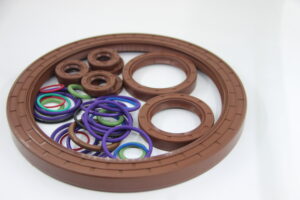Table of Contents
ToggleHow Many Types of Oil Seals Are There?
Oil seals, also known as rotary shaft seals or radial lip seals, are vital components in machinery to retain lubricants, exclude contaminants, and maintain pressure. Their diversity arises from varying design features, materials, and application-specific requirements. While there is no fixed “number” of oil seals due to evolving designs and custom solutions, they can be broadly categorized into 6–8 primary types, with further subdivisions based on industry standards, materials, and specialized applications. Below is a comprehensive breakdown of their classifications and uses.



1. Classification by Lip Design
The number and geometry of sealing lips define functionality and protection levels:
- Single Lip Seals:
- Basic Design: One sealing lip for general-purpose use.
- Applications: Gearboxes, motors, and systems with low contamination risk.
- Double Lip Seals:
- Enhanced Protection: Primary sealing lip + secondary dust lip to block dirt, water, and debris.
- Applications: Harsh environments like agricultural machinery and construction equipment.
- Hydrodynamic Seals:
- Advanced Design: Grooved or helical lip patterns to pump leaked fluid back into the system.
- Applications: High-speed rotating shafts in automotive transmissions or turbines.
2. Classification by Material Construction
Material choice dictates temperature resistance, chemical compatibility, and durability:
- Metal-Cased Seals:
- Rigid Shell: Steel or stainless steel casing for secure press-fit installation.
- Applications: Industrial machinery, automotive engines.
- Rubber-Covered Seals:
- Corrosion Resistance: Fully encapsulated in elastomer for flexibility in corrosive environments.
- Applications: Marine equipment, chemical processing.
- PTFE Seals:
- High Performance: Polytetrafluoroethylene (PTFE) offers low friction and extreme chemical resistance.
- Applications: Aerospace, pharmaceuticals, and high-temperature systems.
3. Classification by Spring Configuration
Springs ensure consistent sealing force against shafts:
- Spring-Loaded Seals:
- Garter Spring: Maintains lip pressure despite shaft wear or vibration.
- Applications: Automotive transmissions, industrial pumps.
- Springless Seals:
- Elastomer Reliance: Depends on material elasticity for sealing.
- Applications: Low-speed systems like household appliances.
4. Classification by Application-Specific Designs
Specialized seals address unique operational challenges:
- Cassette Seals:
- Multi-Component Design: Combines seals, wear sleeves, and elastomers for heavy-duty use.
- Applications: Mining equipment, misalignment-prone systems.
- Wear Sleeves:
- Shaft Rehabilitation: Provides a smooth surface for damaged shafts.
- Applications: Paired with standard seals in aging machinery.
- High-Speed Seals:
- Optimized Materials: Lightweight coatings for reduced friction.
- Applications: Turbochargers, high-RPM machinery.
- High-Pressure Seals:
- Reinforced Structure: Withstands extreme pressures.
- Applications: Hydraulic pumps, oil rigs.
5. Classification by Elastomer Type
Elastomers define performance limits and environmental compatibility:
- Nitrile (NBR):
- Oil and Fuel Resistance: Cost-effective for automotive and general industrial use.
- Fluorocarbon (FKM/Viton®):
- High-Temperature Tolerance: Up to 250°C; ideal for aerospace and chemical processing.
- Silicone (VMQ):
- Low-Temperature Flexibility: Used in food-grade and medical applications.
- Ethylene Propylene (EPDM):
- Weather and Steam Resistance: Common in marine and HVAC systems.
6. Standardized Classifications (ISO/DIN/API)
Industry standards ensure interchangeability and reliability:
- TC (Type C): Metal-cased, single lip.
- SC (Type S): Rubber-covered, single lip.
- TB (Type B): Double-lip variants.
- DIN 3760/3761 Types:
- Type A: Rubber-housed seals.
- Type AS: Type A + dust lip.
- Type B: Metal-cased seals.
- Type BS: Type B + dust lip.
- Type C/CS: Heavy-duty metal-cased seals with/without dust lips.
7. Subcategories by Application Scenarios
Further subdivisions target niche industries and components:
- Automotive Oil Seals:
- Crankshaft Seals: High-temperature, high-speed sealing for engines.
- Wheel Hub Seals: Protect bearings in vehicles.
- Power Steering Seals: Prevent fluid leaks in steering systems.
- Hydraulic Oil Seals:
- High-Pressure Seals: Reinforced designs for hydraulic pumps.
- Rotary Hydraulic Seals: For dynamic hydraulic systems.
- Industrial Oil Seals:
- Conveyor Seals: Dust and moisture exclusion in manufacturing.
- Pump Seals: Chemical and abrasion resistance.
- Consumer Goods:
- Washing Machine Seals: Corrosion resistance and affordability.
- Appliance Motor Seals: Prevent lubricant leakage in household devices.
- Aerospace Oil Seals:
- Fuel System Seals: High chemical and temperature resistance.
- Turbine Shaft Seals: Lightweight and durable for jet engines.
8. Specialized and Brand-Specific Seals
Examples of tailored solutions:
- TCV/TCN Seals:
- TCV: Double-lip or dust-resistant variants.
- TCN: Single-lip for medium-pressure applications.
- HTCR Seals:
- High-Temperature/Clockwise Installation: Marked for specific directional use.
- Toyota Oil Seals:
- OEM Specifications: Custom designs for Toyota vehicles.
- Viton® Seals:
- Premium Fluoropolymer: Superior chemical and heat resistance.
- CR Seals (Neoprene):
- Moderate Chemical Resistance: General-purpose industrial use.
Conclusion
While oil seals can be grouped into 6–8 primary categories (lip design, material, spring type, etc.), their subtypes extend into dozens of specialized designs tailored to industries like automotive, aerospace, and hydraulics. The exact “number” of oil seals is fluid due to continuous innovation, but understanding core classifications ensures informed selection for performance, durability, and cost-efficiency. Always consult manufacturer guidelines or sealing experts for application-specific requirements.



Leave A Comment